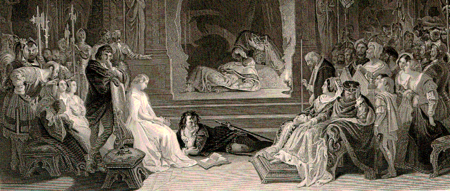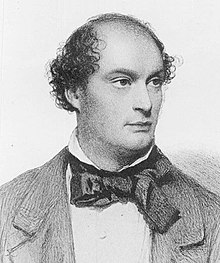Daniel Maclise
Daniel Maclise | |
|---|---|
 Daniel Maclise photographed by William Lake Price | |
| Born | 25 January 1806 |
| Died | 25 April 1870 (aged 64) Chelsea, England |
| Nationality | Irish |
| Known for | History painting; Portrait painting |




Daniel Maclise
Early life
Maclise was born in
Various influential friends recognised Maclise's genius and promise, and were anxious to furnish him with the means of studying in London; but refusing all financial assistance, he saved the money himself and arrived in the capital on 18 July 1827. There he made a sketch of
Career
Maclise exhibited for the first time at the Royal Academy in 1829. Gradually he began to confine himself more exclusively to subject and historical pictures, varied occasionally by portraits – such as those of
He also designed illustrations for several of Dickens's Christmas books and other works. Between the years 1830 and 1836 he contributed to Fraser's Magazine, under the pseudonym of Alfred Croquis, a remarkable series of portraits of the literary and other celebrities of the time – character studies, etched or lithographed in outline, and touched more or less with the emphasis of the caricaturist, which were afterwards published as the Maclise Portrait Gallery (1871).[3] During the rebuilding of the Houses of Parliament in London in 1834–1850 by Charles Barry, Maclise was commissioned in 1846 to paint murals in the House of Lords on such subjects as Justice and Chivalry.[4][5]
In 1858, Maclise commenced one of the two great monumental works of his life,
Maclise's vast painting of The Marriage of Strongbow and Aoife (1854) hangs in the National Gallery of Ireland, Dublin.[7] It portrays the marriage of the main Norman conqueror of Ireland "Strongbow" to the daughter of his Gaelic ally. By the grand staircase of Halifax Town Hall, which was completed in 1863, there is a wall painting by Maclise.[8][9]
The intense application which he gave to these great historic works, and various circumstances connected with the commission, had a serious effect on the artist's health. He began to shun the company in which he formerly delighted, his old buoyancy of spirits was gone, and when, in 1865, the presidency of the Royal Academy was offered to him he declined the honour. He died of acute pneumonia on 25 April 1870 at his home 4 Cheyne Walk, Chelsea.[2][10]
His works are distinguished by powerful intellectual and imaginative qualities, but, in the opinion of Monkhouse, a late Victorian critic, somewhat marred by harsh and dull colouring, by metallic hardness of surface and texture, and by frequent touches of the theatrical in the action and attitudes of the figures. His fame rests most securely on his two greatest works at Westminster.[2]
A memoir of Maclise, by his friend William Justin O'Driscoll, was published in 1871.[1]
Posthumous exhibitions
National Portrait Gallery, 1972
The works of Maclise in portraiture were celebrated in 1972 at an exhibition in the National Portrait Gallery.[11]
Crawford Art Gallery, 2008
The
Royal Academy, 2015
The preliminary sketch for The Meeting of Wellington and Blücher was displayed at the Royal Academy of Arts from 2 September 2015 to 3 January 2016, to commemorate the 200th anniversary of the Battle of Waterloo.[11][13] It had been displayed previously from 23 May until 23 August at the Royal Armouries in Leeds as part of the Waterloo 1815: The Art of Battle exhibition.[13]
References
- ^ a b c Chisholm 1911.
- ^ a b c Monkhouse 1885–1900.
- ^ Maclise, Daniel & Bates, William. The Maclise portrait-gallery of "illustrious literary characters" etc. (London: Chatto and Windus, 1883)
- ^ The spirit of chivalry (Art in Parliament).
- ^ The complex history surrounding the decoration is best summarized by
CourtauldInstitutes 17:1954, pp. 319–358.
- ^ The Meeting of Wellington and Blucher after the Battle of Waterloo (Art in Parliament).
- ^ The Marriage of Strongbow and Aoife ("Ask about Ireland").
- ^ Wall painting by Maclise in Halifax Town Hall.
- ^ English Heritage National Monuments Record: description of Halifax Town Hall, mentioning Maclise wall painting.
- ^ "Settlement and building: Artists and Chelsea Pages 102-106 A History of the County of Middlesex: Volume 12, Chelsea". British History Online. Victoria County History, 2004. Retrieved 21 December 2022.
- ^ a b telegraph.co.uk: "Daniel Maclise: The Waterloo Cartoon, Royal Academy, review: 'fascinating'", 1 Sep 2015
- ISBN 978-0-948037-66-5
- ^ a b royalacademy.org: "Daniel Maclise's cartoon for 'The Meeting of Wellington and Blücher' is a preparatory drawing on an epic scale."
Attribution
- Monkhouse, William (1885–1900). . Dictionary of National Biography. London: Smith, Elder & Co.
- This article incorporates text from a publication now in the public domain: Chisholm, Hugh, ed. (1911). "Maclise, Daniel". Encyclopædia Britannica. Vol. 17 (11th ed.). Cambridge University Press. pp. 262–263.
External links
- 46 artworks by or after Daniel Maclise at the Art UK site
- Works by Daniel Maclise at Project Gutenberg
- Works by or about Daniel Maclise at Internet Archive
- Maclise on the UK Parliament website
- Daniel Maclise online (Artcyclopedia)
- Daniel Maclise on Artnet
- Daniel Maclise biography (London atelier of representational art)
- Daniel maclise biography (Encyclopedia of Irish and World Art)
- Daniel Maclise at Art Renewal Center
- Profile on Royal Academy of Arts Collections
- An engraving by P Lightfoot of
 The Hall of Glennaquoich—A Highland Feat. for Fisher's Drawing Room Scrap Book, 1837 with a poetical illustration by Letitia Elizabeth Landon.
The Hall of Glennaquoich—A Highland Feat. for Fisher's Drawing Room Scrap Book, 1837 with a poetical illustration by Letitia Elizabeth Landon.
